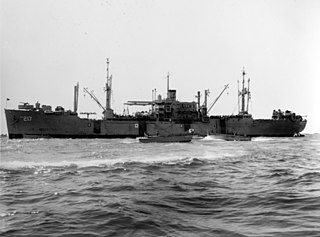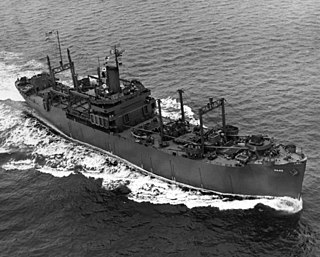
USS Pensacola (CL/CA-24) was a cruiser of the United States Navy that was in service from 1929 to 1945. She was the lead ship of the Pensacola class, which the navy classified from 1931 as heavy cruisers. The third Navy ship to be named after the city of Pensacola, Florida, she was nicknamed the "Grey Ghost" by Tokyo Rose. She received 13 battle stars for her service.

USS Morris (DD-417), a World War II-era Sims-class destroyer in the service of the United States Navy, was named after Commodore Charles Morris. She was among the most decorated US Naval vessels of World War II.

USS Neville (AP-16/APA-9) was a Heywood-class attack transport in service with the United States Navy from 1918 to 1919 and from 1940 to 1946. She was scrapped in 1957.

USS Stack (DD-406) was a Benham-class destroyer in the United States Navy. She was named for Edward Stack.

USS Aquarius (AKA-16) was an Andromeda-class attack cargo ship in the service of the United States Navy. She was named after the constellation Aquarius. She was one of a handful of World War II AKAs manned by officers and crew from the United States Coast Guard. She served as a commissioned ship for 2 years and 9 months.

USS LeHardy (DE-20) was an Evarts-class destroyer escort constructed for the United States Navy during World War II. It was promptly sent off into the Pacific Ocean to protect convoys and other ships from Japanese submarines and fighter aircraft. At the end of the war, she had to honor of proceeding to Wake Island, as the Japanese commander surrendered, and raising a flagpole to fly the American flag once again.

USS New Kent (APA-217) was a Haskell-class attack transport in service with the United States Navy from 1944 to 1949 and from 1951 to 1954. She was scrapped in 1972.

USS Heywood (APA-6) was a Heywood-class attack transport acquired by the U.S. Navy for service as a troop carrier during World War II. She served in the Pacific War, a very dangerous area in the early years of the war, and safely returned home post-war with seven battle stars to her credit.

USS Harry Lee (APA-10) was a Harry Lee-class attack transport that saw service with the US Navy during World War II. She served in the Pacific War, as well as in North Atlantic Ocean operations, and safely returned home post-war with seven battle stars to her credit. She was the only ship in her class.

USS Lesuth (AK-125) was a Crater-class cargo ship commissioned by the US Navy for service in World War II. Lesuth was named after the star Lesuth in the constellation Scorpius. She was responsible for delivering troops, goods and equipment to locations in the Asiatic-Pacific Theater.

USS Custer (AP-85/APA-40) was a Bayfield-class attack transport in service with the United States Navy from 1943 to 1946. She was sold into commercial service in 1948 and was scrapped in 1973.

USS Fayette (APA-43) was a Bayfield-class attack transport that served with the United States Navy from 1943 to 1946. In 1947, she was sold into commercial service, where she served as SS Robin Gray until being scrapped in 1972.

USS Windsor (APA-55) was a Windsor-class attack transport in service with the United States Navy from 1943 to 1946. She was scrapped in 1972.

USS Ormsby (APA-49) was an Ormsby-class attack transport that served with the US Navy from 1943 to 1946. She was subsequently sold into commercial service and was scrapped in 1969.

USS Pierce (APA-50) was an Ormsby-class attack transport that served with the US Navy during World War II.

USS Crescent City (AP-40/APA-21) was the lead ship of the Crescent City-class attack transports that served with the US Navy during World War II. The ship was built as the cargo and passenger liner Delorleans for the Mississippi Shipping Company's Delta Line. After brief commercial operation the ship was among 28 vessels requisitioned in June 1941 for the Navy and the Army. The Navy renamed the ship Crescent City, a popular nickname for New Orleans, Louisiana, upon commissioning 10 October 1941. The ship was decommissioned and laid up in 1948 before being loaned to the California Maritime Academy to serve as a training ship 1971–1995 and then transferred to a foundation in a failed art colony project. The ship left California for Texas scrapping in 2012.

USS Harris (APA-2) was an Emergency Fleet Corporation Design 1029 ship launched for the United States Shipping Board (USSB) on 19 March 1921 by Bethlehem Shipbuilding Corporation, at Sparrows Point, Maryland as Pine Tree State. After operation by commercial lines for the USSB, during which the ship was renamed President Grant and operated commercially until laid up in the late 1930s.

USS Zeilin (APA-3) was an Emergency Fleet Corporation Design 1029 ship launched for the United States Shipping Board (USSB) on 19 March 1921 by Newport News Shipbuilding and Drydock Company in Newport News, Virginia as Silver State. After operation by commercial lines for the USSB, during which the ship was renamed President Jackson, the ship was purchased and operated commercially until laid up in the late 1930s.

USS William P. Biddle (APA-8) was a Heywood-class attack transport in service with the United States Navy from 1941 to 1946. She was scrapped in 1957.

USS George Clymer (APA-27) was an Arthur Middleton-class attack transport that saw service with the US Navy in four wars - World War II, the Chinese Civil War, the Korean War and the Vietnam War. It was named after United States Founding Father George Clymer.




















